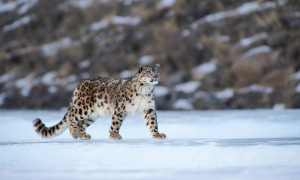NEW DELHI, Jan 30: Union Minister of Environment, Forest, and Climate Change Bhupender Yadav, during the National Board for Wildlife meeting in New Delhi, on Tuesday unveiled a report related to the first-ever scientific exercise that was carried out by the Wildlife Institute of India (WII), revealing a count of 718 snow leopards.
The initiative, known as the Snow Leopard Population Assessment in India (SPAI) programme, marks the country’s maiden scientific undertaking to gauge the population of these elusive creatures.
The Wildlife Institute of India (WII) is the National Coordinator for this exercise which was carried out with support the support of all snow leopard range states and two conservation partners, the Nature Conservation Foundation, Mysuru and WWF-India.
The assessment covered over 70 per cent of the potential snow leopard range in the country, covering approximately 120,000 km2 of crucial snow leopard habitat across the trans-Himalayan region, including the Union territories of Ladakh and Jammu and Kashmir, and states such as Himachal Pradesh, Uttarakhand, Sikkim, and Arunachal Pradesh.
The exercise was conducted from 2019 to 2023 using a meticulous two-step framework. Snow leopard abundance was estimated using camera traps in each identified stratified region.
During the exercise, total efforts included: 13,450 km of trails surveyed for recording Snow leopard signs, while camera traps were deployed at 1,971 locations for 180,000 trap nights.
The snow leopard occupancy was recorded in 93,392 km2, with an estimated presence in 100,841 km2. A total of 241 unique snow leopards were photographed.
Based on data analysis, the estimated population in different states are Ladakh (477), Uttarakhand (124), Himachal Pradesh (51), Arunachal Pradesh (36), Sikkim (21), and Jammu and Kashmir (9).
Until recent years, the snow leopard range in India was undefined due to a lack of extensive nationwide assessments for this vulnerable species. Before 2016, approximately one-third of the range (around ca. 100,347 km2) received minimal research attention, reduced to just 5 per cent in pockets like Ladakh, Jammu and Kashmir, Uttarakhand, and Himachal Pradesh.
Recent status surveys have significantly increased understanding, providing preliminary information for 80 per cent of the range (about 79,745 km2), compared to 56 per cent in 2016.
The report also mentioned the need for establishing a dedicated snow leopard cell at Wildlife Institute of India under the Ministry, with a primary focus on long-term population monitoring, supported by well-structured study designs and consistent field surveys.
For the same, states and UTs can consider adopting a periodic population estimation approach (every 4th year) in the snow leopard range. These regular assessments will offer valuable insights for identifying challenges, addressing threats, and formulating effective conservation strategies

